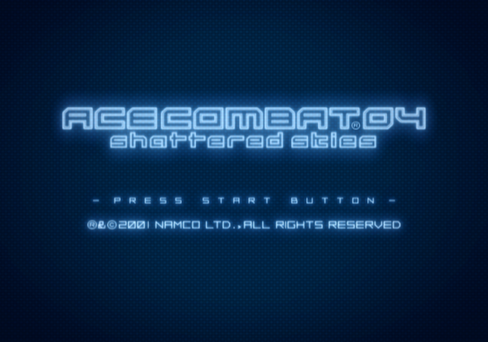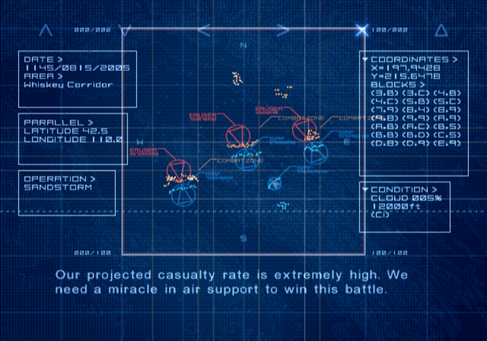Ace Combat 04: A Modern Day Retrospective
- T.J. "Millie" Archer
- Nov 1
- 10 min read
A Critical Eye of a Series Classic

I’m not sure you could make Ace Combat 04 today.
Ace Combat 04 (2001) is an axiomatic military techno-thriller wrapped in a character documentary; a time capsule of a popular interpretation of western military organization and professionalism put through an obsessive Japanese lens surrounded by the post-postmodern framing of a classic war movie. A melting pot of Allied heroism of World War II powered by the echoes of post-Gulf War UN Coalition victory and a recent historical Cold War lens. It hearkens to a time when right made might.

But does this even vibe with today’s post-truth forever wars? With Ace Combat’s hell-bent insistence on a postmodern bend through what now makes up the vast majority of its chronology, the classical interpretations of 04 not only feel dated and quaint, it almost seems alien. It feels so distant now that it’s hard to believe we could have ever related to its sincerity. In fact, it seems bizarre to believe that this game was the one that launched the Strangereal universe we follow today.
The AC04 Project had its work cut out for it to come off the heels of Ace Combat 3 (1999). Neutered in its export release, it took a few years for the internet to mature for us to understand what we missed in that drop. But for what we had in our hands, it was… kinda strange. Even today it still acts as much its own game outside of its series and can be appreciated as a singular entity. It’s a rather strong (if derivative) cyberpunk postulate disguised as a war game. If we were to be realistic about this game’s western demographic skewing younger than the “teen” ESRB rating would have wanted, Ace Combat 3 probably wasn’t very accessible by the majority of its players.
That would change with Ace Combat 04.
The 2000 TGS trailer presents a bleak but familiar setting, panning over what you learn to be Newfield Island while a static-stricken pair of aviators speak through. Modern-day aircraft cut through the air as the high-energy trailer unfolds and the music rises in what resonates in desperation while the AWACS and pilot vector to engagement. A flash of light at the end and a receding shot of Anderson Crater, delivering the backdrop of a planet rocked by a cataclysmic event and foreshadowing the world-class visual storytelling to come.
It could probably be surmised that Ace Combat 04 was developed in the zeitgeist of the World War II shooters of the time, with the cinematic and story-driven Medal of Honor defining the atmosphere. Project Aces would dip into this type of inspiration many times over the next few years with varying levels of success.
UI/UX Design
The acuity of Ace Combat 04’s aesthetic delivers an emulsification of digital and analog presentation, almost as though they recognized the end of an oncoming era. On a CRT of the time, the artificial scan lines and faded colors presented a traditional warmth in sharp contrast with Electrosphere. There’s no flash of action here. Just simple options to select, and a muted backdrop.
The range of cool blues meet a digital teletype font that feels straight out of the movie WarGames. The distinctive sound of a thrashing hard drive and a flash lamp powering up for each briefing across a simple lined overlay and vector-inspired map invokes a well-equipped but aging technological atmosphere.
Music
The motif of the Independent State Allied Forces is presciently represented in just about every piece of music that the game presents. The ISAF theme proper itself presents in a triumphant symphony during the introduction of the war’s catalyst, properly driving home the importance of the military alliance that you fight to defend and avenge. Sitting Duck takes the theme and within the short time you hear it provides a trifecta of atmosphere, combining a down tempo electronic/brass introduction and a desperate cadence as it climaxes into a high action guitar.
Motifs continue to play an important role in story immersion, with Stonehenge’s theme prominent whenever you are threatened by the turret network’s onslaught in the early game. The theme proper makes an explosive entrance in mission 12, never letting up on the horror of the machination that you are there to destroy.
The music expands beyond the tactical into the strategic—once you’ve turned the tide, Second Strike blankets your briefings going forward, injecting fresh energy into the offensive phase of the war. Each time it fires up it enhances the power fantasy that the game builds to with your avatar.
The game concludes with the epic symphony and choir of Agnus Dei, revisiting the ISAF motif for a penultimate time in such a massive cacophony that it may not immediately be identifiable to the untrained ear. It succeeds in spades no matter your decision to extend the fight in your engagement with Yellow Squadron or to desperately remove the final Ulysses threat from your fragile victory in Farbanti.
Cutscenes
It’s remarkable how serious Ace Combat 04 presents its story and its hard to explain how respectful the game treats its outlook on war. Devoid of humor and drowning in melancholy, the intertwining story and themes presented in the narrative interludes weaves brilliantly with Mobius One’s airborne exploits. The hand-drawn, hand-colored illustrations that chronicle the Continental War are presented in the style of a graphic novel while the audio, reminiscent of a radio drama with vocal narration peppered with an effective sound set, follow the experiences of the narrator living as a child in an Erusian occupied San Salvacion.
From the first moment we are taken into a very consequential world—kicking the story off with an understated personal tragedy and an enigmatic vow. It carries a quote that is also rather profound:
“War was an abstract idea, nothing more than a show on TV … something that happened in a faraway land.”
Obvious perhaps, but almost deliberately understated. It sets the tone going forward so presciently.
Each cutscene carries purpose and vision, often expressed with poetic resolve. The narration’s gloomy tone never lets up, yet never feels melodramatic or boring. This presentation is world-class, and is just as fitting as a standalone story that remains under-appreciated for video games in the present day, let alone during its own time. It carries multiple themes of resistance, capitulation, self-doubt, and resilience. It slowly interweaves your actions into the story about one-third of the way through as Yellow 13 calls you out, and your actions start having more direct consequences by the halfway point when you down his trusted wingman. This trickle of narrative interplay is key to the atmosphere of the game and carries half the weight of the power fantasy build up that encompasses the mythos of Mobius One—you.
The Heroic Ace
Ace Combat 04 introduced the now ‘series standard’ concept of the player becoming a heroic ace pilot in a modern battlefield. In Ace Combat 1 (1995) and Ace Combat 2, we play as barely referred to mercenary forces, who even in the final stages of these games, are not receiving direct name appreciation. The full story of Ace Combat 3 is an abstract concept removed from a traditional war setting with players playing as an artificial intelligence named ‘Nemo’ (Greek for “Nobody”). While their actions impacted the story they were really more of a pawn in an elaborate plot than anything else.
It is not until Ace Combat 04 that the name brand hero tradition begins. Whether it was the silent burning admiration of an opposing squadron or friendly rifleman yelling over the radio in celebration, the ‘legendary’ Mobius One was known to be flying above the battlefield. This same pilot would go on to appear in future releases as easter eggs and standalone game modes in future Ace Combat games. All player controlled protagonists after Ace Combat 04 would be built around common plot points that take them from relatively unknown individuals to known by name heroes that were the sole deciding factor in the ultimate outcome of a war.
While that is great for Ace Combat and the “Ace-like” genre the series has spawned, these days, even the World War coded concept of ace pilots being public facing figures changing the tide of battle and inspiring nations is lost in the modern perception of armed conflict. For example, the same weekend the Ghost of Kyiv was introduced as a staunch defender of Ukrainian skies in 2022, it could be seriously argued that the international view of the existence of such a pilot on a modern battlefield was never fully accepted as fact. It just seemed impossible today.
However, when we turn to movies and generation defining flight games like Ace Combat, the belief of the war winning, ode worthy ace pilot still outshines the reality of the conditions such a pilot would exist in.
Control and Gameplay
Ace Combat 04 is a return to tradition away from Ace Combat 3, taming turning recoil to such a degree and restoring complete analog control that the only limitations to your capability are yours and yours alone. With a limited selection of aircraft available to you each aircraft feels properly unique in the way it handles.
Turn rates have just enough variety as you advance through your hangar selection that you will want to advance your collection. However, roll rates in late-model aircraft will feel exaggerated, with complete rolls being possible in what feels like a split second. Combined together, as mobility stats increase, aircraft tend to exhibit a prominent tailslide which can betray you in a low-altitude pull, with the Su-37 being egregious in this regard.

However, between a combination of the modest acceleration and a working low-speed angle-of-attack physics you’ll find that it almost grants you passive post-stall mechanic. The analog triggers of the PlayStation 2 are in full display here, granting fine control of both throttle and yaw. This is best demonstrated when performing carrier ops, where careful manipulation of the throttle provides a modest simulation of a flared nose on takeoff and landing.
Though there are clear flaws in the handling mechanics of Ace Combat 04, it retains a unique character that merges Newtonian flight mechanics with arcade feel in ways that no release that followed it provides.
All this comes together to provide the familiar gameplay loop we’re used to. The refinement of it perhaps--though Ace Combat 2 defined the base mechanics that we’re used to, Ace Combat 04 solidified it, providing the combination of aircraft, secondary weapon, and livery that persists throughout the series and it’s contemporaries.
Mission Design
It would be hard to explain that the cliché of the back from the brink bomber intercept didn’t exist in quite the same way as it does today. At the time, Sitting Duck was breathtaking. If you subscribe to the interpretation that Ace Combat 04 is actually a soft reboot of Ace Combat 2 (1997), the implications are self-evident; a graphics and sound uplift rivaling that of the new generation of fidelity that the Playstation 2 represented over it’s predecessor. Combined with the desperation of the muted color palette, music, and voiceovers, what is effectively a simple tutorial mission becomes a perfect jump point for the story.
This extends into Imminent Threat, which provides a soft but comprehensive familiarization for ground attack mechanics and a chance to use the secondary weapon that was teased to you in the hanger. It also presents a subtle but important detail of the thought put into what each mission represents tactically. Take out the substation, Mobius One.
Deep Strike is still unparalleled in how it hid the fact that it is the representation of the typical canyon strike mission that remains a staple of the flight arcade genre. It also subverts the genre in that it provides story-based context for why you can’t exceed the altitude of the canyon walls as Stonehenge unleashes its fury against you and your comrades. All this wrapped within a rational mission objective that is actually quite satisfying to practice your gun marksmanship on.

Comona remains the pinnacle of arcade furballs and has not yet been succeeded, despite valiant efforts in every game following. Fast paced with multiple objectives, its all-air-to-air, all-the-time, with only the most skilled players succeeding in clearing the map of threats. Backed by a screaming rock guitar and offering a plentiful array of targets, this remains the Ace Combat standby for a no-holds barred de facto air skirmish mode.
These mission types build upon themselves as the missions go on. One could probably make the argument that Ace Combat 04 is the only video game ever made where the escort mission archetype is actually entertaining to play, though it’s something of an escort-in-name-only as even modest skill will keep your charge from falling to the enemy.
Admittedly the mission Broken Arrows might be the only low point in mission design, being both the most egregious filler mission, though still strategically sound for the campaign as a whole. It’s a frustrating tail chase against cruise missiles that bleeds frustration rather than fun. Though it traces its roots back to Ace Combat 2’s late-game missile chase, this is one homage that should have probably stayed tabled.
The Death of the Rational War
In the modern day, particularly from a Western perspective, the ISAF almost seems hyper-competent, and unapologetically so. Each mission’s reason and purpose is clearly communicated during each tightly packed briefing. Any wartime concept the player might be unfamiliar with is laconically described and actually seems to require a novice understanding of real-world military strategy. ISAF pilots and ground forces seem highly competent and well-motivated to perform the missions required of them. The grand strategy to eliminate Stonehenge and advance on Farbanti is layered out and each tactical objective seems to lead into it. There’s no in-flight questioning of the politics of the banner you’re fighting under, just what feels like a unified fight to stop the Erusian war machine.

Whether it’s the explanation that Operation Bunker Shot is required due to Stonehenge covering any possible port landing sites or the push to interdict enemy petrochemical supply lines while covering your own alliance’s build out of space-based intelligence operations, the ISAF’s push into the mainland after the destruction of Stonehenge feels justified and satisfying. Something that doesn’t seem to carry over to later parts of this series.
At one time it was said that the general banter in Ace Combat 5 (2004) wouldn’t be tolerated due to its politically charged, over-explained, emotionally-driven dialogue. It was “unrealistic” compared to its predecessor.
Perhaps in today’s geopolitical climate the opposite is now true.

It would be extremely naïve to think that Ace Combat 04 is nothing but romantic in its portrayal of warfare. Actual combat, no matter what nation partakes, in the air and on the ground, is messy and filled with confusion and chaos. But there was a vestigial aura left over from news, movies, radio, and books that portrayed well-coordinated and well-communicated tactics and strategy from wars fought in the 20th century--A time when wars between powers were as much battles of wit, chivalry, conventions, treaties, and science. A time when wars actually… ended.
Looking back on any real-world conflict with rose-tinted glasses probably eschews nothing but privilege, but from the perspective of “the show on TV” that Ace Combat 04 intuitively touches upon, it’s hard to see the action and dialogue in Ace Combat 04 resonating with a young person who might only have experience and memories of a post GWOT-world. Ace Combat 04’s greatest strength and greatest weakness is the swan song that is the portrayal of warfare as a series of rational actions. Even with the interplay between the homefront portrayed in the cutscenes, it can’t help but feel like Ace Combat 04 is now unrelatable.
About the Writer

T.J. "Millie" Archer is Life-long realist and aviation enthusiast. Once the co-founding Administrator of the Electrosphere.info English Ace Combat Database. In the present day he is freelance, roving the internet in search of the latest aviation news and entertainment. [Read Staff Profile]








































.png)